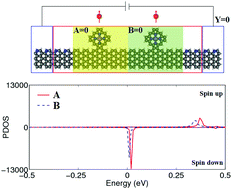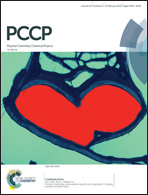A nearly perfect spin filter and a spin logic gate based on a porphyrin/graphene hybrid material
Abstract
Although a lot of theoretical studies have designed perfect spin filters using inorganic/organic/organometallic materials, their fabrication methods are not experimentally feasible. This dilemma could be solved by a recent experiment, where porphyrins have been covalently coupled to graphene edges in a precise manner (Y. He et al., Nat. Chem., 2017, 9, 33–38). In particular, experimental results confirmed that the intrinsic features of porphyrins for metallation are preserved after dehydrogenative coupling to graphene edges, paving the way for realizing synthesizable spintronic devices. Inspired by this work, we report new M-porphyrin/graphene (M = Cr, Mn, Fe, and Co) hybrid systems with tunable functionalities on the basis of nonequilibrium Green's functions in combination with density functional theory. The Mn-porphyrin/graphene hybrid system exhibits an extremely high spin polarization coefficient in a parallel magnetic configuration. Our results also confirm that the magnetic configuration plays an important role in realizing a high-performance spin filter. The interesting spin transport properties in the parallel and antiparallel magnetic configurations also make the hybrid system a suitable candidate for realizing the AND logic operation.



 Please wait while we load your content...
Please wait while we load your content...